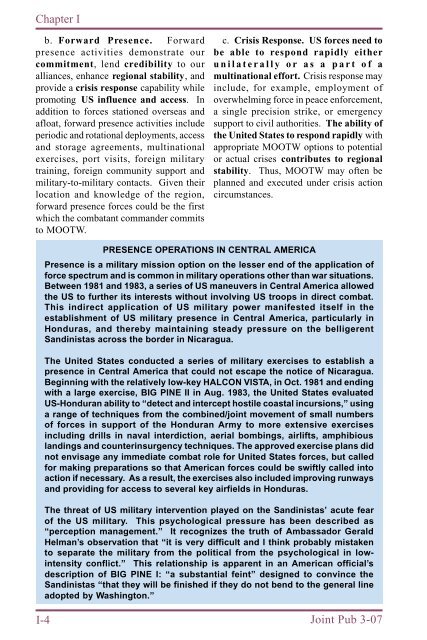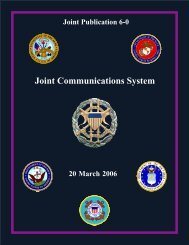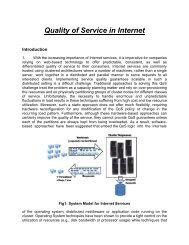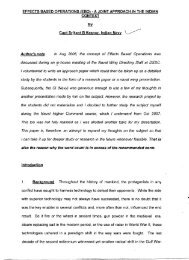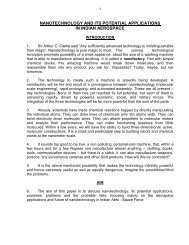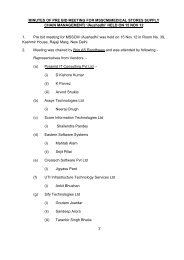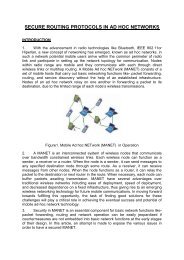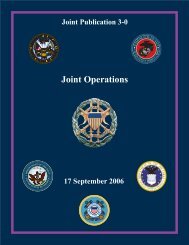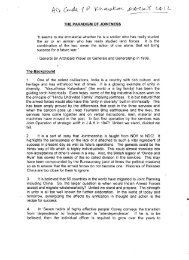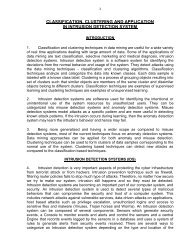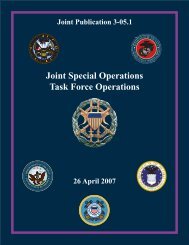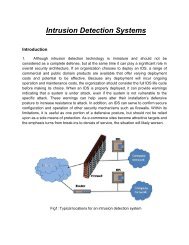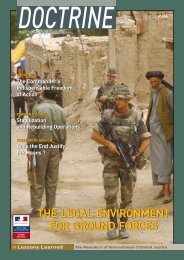JP 3-07 Joint Doctrine For Military Operations Other Than War
JP 3-07 Joint Doctrine For Military Operations Other Than War
JP 3-07 Joint Doctrine For Military Operations Other Than War
- No tags were found...
You also want an ePaper? Increase the reach of your titles
YUMPU automatically turns print PDFs into web optimized ePapers that Google loves.
Chapter Ib. <strong>For</strong>ward Presence. <strong>For</strong>wardpresence activities demonstrate ourcommitment, lend credibility to ouralliances, enhance regional stability, andprovide a crisis response capability whilepromoting US influence and access. Inaddition to forces stationed overseas andafloat, forward presence activities includeperiodic and rotational deployments, accessand storage agreements, multinationalexercises, port visits, foreign militarytraining, foreign community support andmilitary-to-military contacts. Given theirlocation and knowledge of the region,forward presence forces could be the firstwhich the combatant commander commitsto MOOTW.c. Crisis Response. US forces need tobe able to respond rapidly eitherunilaterally or as a part of amultinational effort. Crisis response mayinclude, for example, employment ofoverwhelming force in peace enforcement,a single precision strike, or emergencysupport to civil authorities. The ability ofthe United States to respond rapidly withappropriate MOOTW options to potentialor actual crises contributes to regionalstability. Thus, MOOTW may often beplanned and executed under crisis actioncircumstances.PRESENCE OPERATIONS IN CENTRAL AMERICAPresence is a military mission option on the lesser end of the application offorce spectrum and is common in military operations other than war situations.Between 1981 and 1983, a series of US maneuvers in Central America allowedthe US to further its interests without involving US troops in direct combat.This indirect application of US military power manifested itself in theestablishment of US military presence in Central America, particularly inHonduras, and thereby maintaining steady pressure on the belligerentSandinistas across the border in Nicaragua.The United States conducted a series of military exercises to establish apresence in Central America that could not escape the notice of Nicaragua.Beginning with the relatively low-key HALCON VISTA, in Oct. 1981 and endingwith a large exercise, BIG PINE II in Aug. 1983, the United States evaluatedUS-Honduran ability to “detect and intercept hostile coastal incursions,” usinga range of techniques from the combined/joint movement of small numbersof forces in support of the Honduran Army to more extensive exercisesincluding drills in naval interdiction, aerial bombings, airlifts, amphibiouslandings and counterinsurgency techniques. The approved exercise plans didnot envisage any immediate combat role for United States forces, but calledfor making preparations so that American forces could be swiftly called intoaction if necessary. As a result, the exercises also included improving runwaysand providing for access to several key airfields in Honduras.The threat of US military intervention played on the Sandinistas’ acute fearof the US military. This psychological pressure has been described as“perception management.” It recognizes the truth of Ambassador GeraldHelman’s observation that “it is very difficult and I think probably mistakento separate the military from the political from the psychological in lowintensityconflict.” This relationship is apparent in an American official’sdescription of BIG PINE I: “a substantial feint” designed to convince theSandinistas “that they will be finished if they do not bend to the general lineadopted by Washington.”I-4<strong>Joint</strong> Pub 3-<strong>07</strong>


